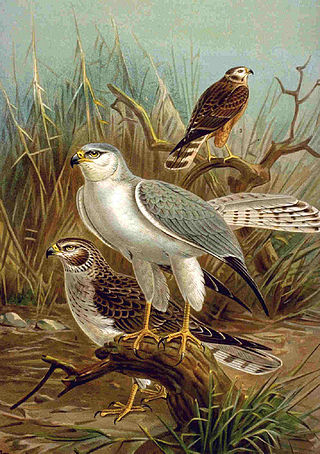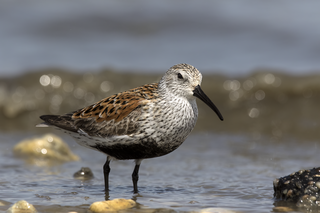
The osprey, , also called sea hawk, river hawk, and fish hawk, is a diurnal, fish-eating bird of prey with a cosmopolitan range. It is a large raptor, reaching more than 60 cm (24 in) in length and 180 cm (71 in) across the wings. It is brown on the upperparts and predominantly greyish on the head and underparts.

The Siberian stonechat or Asian stonechat is a recently validated species of the Old World flycatcher family (Muscicapidae). Like the other thrush-like flycatchers, it was often placed in the Turdidae in the past. It breeds in the East Palearctic including in easternmost Europe and winters in the Old World tropics.

The merlin is a small species of falcon from the Northern Hemisphere, with numerous subspecies throughout North America and Eurasia. A bird of prey once known colloquially as a pigeon hawk in North America, the merlin breeds in the northern Holarctic; some migrate to subtropical and northern tropical regions in winter. Males typically have wingspans of 53–58 centimetres (21–23 in), with females being slightly larger. They are swift fliers and skilled hunters which specialize in preying on small birds in the size range of sparrows to quail. The merlin has for centuries been well regarded as a falconry bird. In recent decades merlin populations in North America have been significantly increasing, with some merlins becoming so well adapted to city life that they forgo migration.

Montagu's harrier (Circus pygargus) is a migratory bird of prey of the harrier family. Its common name commemorates the British naturalist George Montagu.

The pale or pallid harrier is a migratory bird of prey of the harrier subfamily. The scientific name is derived from the Ancient Greek. Circus is from kirkos, referring to a bird of prey named for its circling flight, probably the hen harrier and macrourus is "long-tailed", from makros, "long" and -ouros "-tailed".

The western marsh harrier is a large harrier, a bird of prey from temperate and subtropical western Eurasia and adjacent Africa. It is also known as the Eurasian marsh harrier. Formerly, a number of relatives were included in C. aeruginosus, which was then known as "marsh harrier". The related taxa are now generally considered to be separate species: the eastern marsh harrier, the Papuan harrier of eastern Asia and the Wallacea, the swamp harrier of Australasia and the Madagascar marsh harrier of the western Indian Ocean islands.

The great egret (Ardea alba), also known as the common egret, large egret, or great white egret or great white heron is a large, widely distributed egret. The four subspecies are found in Asia, Africa, the Americas, and southern Europe. Recently it is also spreading to more northern areas of Europe. Distributed across most of the tropical and warmer temperate regions of the world, it builds tree nests in colonies close to water.

The ring-necked duck is a diving duck from North America commonly found in freshwater ponds and lakes. The scientific name is derived from Greek aithuia, an unidentified seabird mentioned by authors including Hesychius and Aristotle, and Latin collaris, "of the neck" from collum, "neck".

The black-winged stilt is a widely distributed very long-legged wader in the avocet and stilt family (Recurvirostridae). The scientific name H. himantopus is sometimes applied to a single, almost cosmopolitan species. Alternatively, it is restricted to the form that is widespread in Europe, Asia and Africa, which equals the nominate group of Himantopus himantopussensu lato. Most sources today accept 1–4 species. The scientific name Himantopus comes from the Greek meaning "strap foot" or "thong foot".

The dunlin is a small wader, formerly sometimes separated with the other "stints" in the genus Erolia. The English name is a dialect form of "dunling", first recorded in 1531–1532. It derives from dun, "dull brown", with the suffix -ling, meaning a person or thing with the given quality.

The Eurasian or common whimbrel, also known as the white-rumped whimbrel in North America, is a wader in the large family Scolopacidae. It is one of the most widespread of the curlews, breeding across much of subarctic Asia and Europe as far south as Scotland. This species and the Hudsonian whimbrel have recently been split, although some taxonomic authorities still consider them to be conspecific.

The greater spotted eagle, also called the spotted eagle, is a large bird of prey. Like all eagles, it belongs to the family Accipitridae. Its feathered legs indicate that it is a member of the subfamily Aquilinae, also known as the "booted eagles." This species was once thought to be a member of the genus Aquila, but was reclassified to a distinct genus, Clanga, along with the two other species of spotted eagle.

The white-tailed kite is a small raptor found in western North America and parts of South America. It replaces the related Old World black-winged kite in its native range.

The Levant sparrowhawk is a small bird of prey. It measures 32–38 cm (13–15 in) in length with a wingspan of 65–75 cm (26–30 in). The female is larger than the male, but the difference is not as marked as with Eurasian sparrowhawk. The adult male is blue-grey above, with dark wingtips, and barred reddish below.
The Helm Identification Guides are a series of books that identify groups of birds. The series include two types of guides, those that are:

The glaucous-winged gull is a large, white-headed gull. The genus name is from Latin Larus which appears to have referred to a gull or other large seabird. The specific glaucescens is Neo-Latin for "glaucous" from the Ancient Greek, glaukos, denoting the grey color of its wings.
Dick Forsman is a Finnish ornithologist. He is the author of The Raptors of Europe and the Middle East: A Handbook of Field Identification which was selected as one of Birdwatch's Outstanding Bird Books of 1998 due in part to its photography. Forsman is also the author of Flight Identification of Raptors of Europe, North Africa and the Middle East, which was published in 2016. Both books were published by Bloomsbury imprint Christopher Helm.

The eastern crowned warbler is a species of Old World warbler in the family Phylloscopidae. It inhabits boreal and temperate forests in the east Palearctic.

The Collins Bird Guide is a field guide to the birds of the Western Palearctic.

The Abyssinian wheatear, or Abyssinian black wheatear, is a species of bird in the family Muscicapidae. It is found from Ethiopia to southern Kenya and northeastern Tanzania.


















